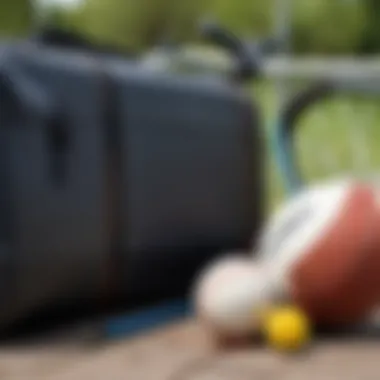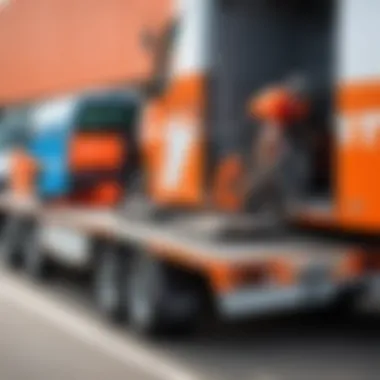Comprehensive Regulations for Transporting Sports Equipment


Intro
Transporting sports equipment can be a complex endeavor, often governed by a myriad of regulations and legal frameworks. As athletes and travelers embark on their journeys, they face unique challenges ranging from understanding airline policies to adhering to international customs laws. This article aims to clarify the rules and guidelines that surround the transportation of sports gear, offering practical tips and insights for ensuring smooth transit whether one is traveling domestically or internationally.
Popular Destinations
Understanding where sports enthusiasts are heading can provide valuable context for regulations surrounding equipment transport. Various popular destinations have specific rules depending on the sport, local laws, and transport options.
Unique Destinations for Exotic Travels
In regions known for adventure sports, such as New Zealand or Costa Rica, local regulations might dictate the type of gear allowed on public transport or private shuttles. For example, in New Zealand, regulations may be more relaxed for travelers needing surfboards or mountain bikes. However, it is vital to check local guidelines before departure. Ensure all equipment meets safety standards. Not only does this guarantee compliance, but it also enhances safety.
Comfortable Places for Family Getaways
Thinking about family trips provides another perspective. Many families travel with sports equipment, be it bicycles, skateboards, or fishing gear. Familiarity with luggage policies on airlines can eliminate stressful surprises during travel. Each airline has its specifications, usually stated on their official website. It is advisable to review this information ahead of time. Additionally, arriving at the airport with all necessary documentation will aid compliance.
Preparing for the Journey
Preparation is key when transporting sports equipment.
Tips for Choosing the Route
When organizing a route, consider dialing in on the details. Whether driving across states or flying internationally, knowing which highways or routes allow for safe transport can streamline your journey. Furthermore, some transportation services specialize in accommodating sports gear, offering customized solutions tailored to cyclists, climbers, and other athletes. Utilizing these services can alleviate much of the stress.
How to Pack Effectively: Handy Tips
Packing sports equipment correctly is crucial. Below are some helpful tips:
- Use protective gear: Invest in quality bags or protective casings to prevent damage during transit.
- Label your equipment: Always label your bags with contact information, especially when flying.
- Check weight limits: Ensure compliance with weight restrictions to avoid excess baggage fees.
"Properly packing your equipment not only ensures its safety but also facilitates faster transitions during travel."
Understanding regulations for each mode of transport can mitigate potential issues. For instance, when flying with a golf bag, airlines may have specific fees or limitations on weight. Research these differences in advance.
Epilogue
Transporting sports equipment requires careful attention to various regulations and guidelines. From understanding popular travel destinations, to efficient packing strategies, being well-informed can significantly enhance the travel experience. Athletes and travelers should always strive for compliance, enhancing not only convenience but also the protection of valuable sports gear.
Foreword to Transporting Sports Equipment
Transporting sports equipment can often prove to be a complex task. As more people travel for competitions, training camps, or leisure activities, understanding the regulations surrounding the transport of these items becomes crucial. Knowledge of these regulations ensures not only the safe arrival of equipment, but also adherence to legal frameworks that vary widely depending on location and mode of transport. This knowledge can mean the difference between a successful trip and encountering substantial delays or fines.
The Importance of Understanding Regulations
Comprehending the regulations related to transporting sports equipment is essential for several reasons. First, it helps athletes and travelers prepare adequately, preventing issues that could arise from non-compliance. Many regions have specific laws governing sizes, weights, and types of equipment allowed. For instance, some airlines impose strict limits on the dimensions of bags and equipment. Ignoring these regulations can lead to additional fees or even the refusal of transport altogether.
Furthermore, international travel introduces additional layers of complexity. Different countries enforce various customs regulations and quarantines that need to be respected. Ensuring compliance can streamline the shipping process, avoiding long delays at border crossings or customs checks that can hinder travel plans.
Overview of Common Types of Sports Equipment
Sports equipment comes in various forms, each with its unique challenges for transport. From bicycles to skis, understanding their specific requirements can help in effectively navigating the regulations. Common types of sports equipment include:
- Bicycles: These must often be disassembled and packed according to airline regulations.
- Skis and Snowboards: These items have specific packaging rules and may entail an additional fee for oversized luggage.
- Surfboards: Length requirements often dictate how they should be transported, as well as potential restrictions on certain carriers.
- Golf Clubs: Usually require a specific case and can incur fees due to their size.
Each type of equipment has its own set of regulations, making it imperative for travelers to familiarize themselves with the specific guidelines related to their sport. Proper preparation and awareness can not only facilitate smoother travel but also protect valuable gear during transit, ensuring a more enjoyable travel experience.
International Guidelines for Sports Equipment Transport


Understanding International Transport Laws
International transport laws are multifaceted and vary from country to country. Several key principles frame these laws. They aim to harmonize practices, enhance safety, and facilitate trade and transport. Compliance with these regulations can prevent legal troubles and financial losses from damaged or lost equipment.
Different modes of transport—air, sea, and land—have unique specifications on how to handle sports equipment. For instance, the International Air Transport Association (IATA) governs air transport. The IATA outlines permissible dimensions, weight restrictions, and packaging standards necessary for items like bicycles, surfboards, or specialty sporting gear.
In contrast, ocean freight regulations might hinge on weight and shipping container specifications, often managed through the International Maritime Organization (IMO). Since laws can also differ based on the path taken, knowing specific destination requirements can save athletes from unnecessary complications.
Key Organizations and Their Roles
Navigating international transport laws effectively involves understanding the roles of several organizations. Key players include:
- International Air Transport Association (IATA): IATA sets worldwide standards for air travel and helps airlines and authorities establish ground rules for transporting various items, including sports equipment.
- International Maritime Organization (IMO): This UN agency regulates shipping industries, which is essential if traveling by sea. It emphasizes safety and environmental standards pertinent to transporting sports gear.
- Customs Authorities: Each nation has its customs laws that affect how goods, including sporting equipment, cross borders. Knowledge of local customs regulations is vital to avoid fines or confiscations.
- National Governing Bodies: Countries often have governing bodies that monitor sporting associations. These organizations might have specific regulations regarding the transport of equipment, affirming standards that ensure athletes compete fairly.
Moreover, staying informed on updates from these organizations can benefit travelers. Laws and guidelines evolve; thus, reliance on accurate, up-to-date information can facilitate more efficient planning and execution of transport.
"Knowing the rules is only half the battle; understanding the implications on transport costs and time is equally essential for athletes and travelers."
Following such guidelines systematically minimizes risks associated with damage, loss, or legal complications during transport. Proper knowledge of international laws and recognizing the significant roles of relevant organizations can empower travelers to transport their sports equipment with greater ease.
National Regulations: A Closer Look
Additionally, being informed about regulations can facilitate a smoother travel experience. Many factors come into play, such as weight limits, packaging requirements, and permissible items. For example, certain countries may have stricter rules regarding specific equipment, like firearms in hunting gear or blades in fencing equipment. A clear understanding of these elements helps travelers prepare adequately.
Regulatory Bodies by Country
Different countries have dedicated regulatory bodies responsible for implementing sports equipment transport regulations. For instance, in the United States, the Transportation Security Administration (TSA) has guidelines that clearly outline what can and cannot be transported. Understanding the role of these organizations is crucial, as they dictate the regulations that travelers must follow.
In Canada, the Canadian Air Transport Security Authority (CATSA) enforces similar regulations. Important bodies in other regions include the European Union Aviation Safety Agency (EASA) and the Australian Transport Safety Bureau (ATSB). Familiarizing oneself with the practices of these regulatory bodies can aid in effective preparation and understanding of the required documentation.
- Examples of Regulatory Bodies:
- Transportation Security Administration (TSA) - USA
- Canadian Air Transport Security Authority (CATSA) - Canada
- European Union Aviation Safety Agency (EASA) - EU
- Australian Transport Safety Bureau (ATSB) - Australia
Recent Changes to National Laws
Sports equipment transportation laws are subject to change. Keeping abreast of these updates is vital for compliant travel. For instance, some countries have been adjusting their laws to respond to increasing security concerns or environmental policies. Many new regulations are aimed at balancing effective security measures with the convenience of travelers.
Recent examples include new restrictions on lithium batteries found in many sports devices. Various nations have begun to enforce stricter rules to ensure safety. Additionally, some countries have streamlined their regulations to ease the burden on athletes traveling for competitions. Conducting regular research or subscribing to updates from relevant authorities can help travelers stay informed about these changes.
"Awareness of current regulations can significantly reduce stress during travel, allowing athletes to focus on performance."
In summary, becoming familiar with national regulations is an ongoing process. Athletes and travelers must continuously adapt to changing laws to ensure a hassle-free journey.
Airline Specific Policies
Airline specific policies regarding the transportation of sports equipment are crucial for travelers who carry such items on flights. Each airline has its own rules that dictate how equipment should be handled, what fees may apply, and how items are categorized. Understanding these policies can also save time and reduce stress during travel. Misunderstanding regulations can lead to unexpected costs and complications when trying to board flights with sports gear.
General Rules for Carrying Sports Equipment
Most airlines require that sports equipment be properly packed and may have restrictions on size and weight. Here are some general rules commonly enforced:
- Weight Limits: Airlines often have strict weight limits for checked baggage and sports equipment. Commonly, this limit is around 50 pounds, but it may vary by airline.
- Dimensions: Items exceeding specific dimensions might incur extra fees. Typical sizes may range from 62 inches in linear dimensions for checked luggage.
- Special Handling: Certain sports equipment, like bicycles, may require special handling fees and packaging. Airlines often mandate a specific type of box or bag for protection.
- Declaration: Travelers must declare oversized items at check-in to ensure they are processed correctly.
The benefits of adhering to these rules include seamless boarding and reduced risk of equipment damage during transit.
Comparative Analysis of Major Airlines


Not all airlines approach sports equipment transport in the same way. Below is a comparison of policies from three major airlines:
- American Airlines: Allows sports equipment as checked baggage with standard fees. Items weighing over 70 pounds incur extra charges, and specific equipment like skis or snowboards may have unique packing requirements.
- Delta Airlines: Offers a generous allowance for some sports equipment, encouraging travelers to bring gear along. Most items are subject to the standard checked baggage fee unless they exceed weight limits.
- United Airlines: Similar to American, United requires that bulky items be declared at check-in. They may assess fees for excess dimensions, and different equipment types can incur varying charges.
Understanding and comparing these airline policies can ensure a smoother travel experience, especially when transporting fragile and valuable sports gear.
Legal Considerations During Transport
Understanding the legal aspects of transporting sports equipment is essential for athletes and travelers alike. Failing to comply with these regulations can lead to significant problems such as equipment damage, financial losses, and legal challenges. This section will explore the crucial elements of liability and insurance regarding the transport of sports gear.
Liability for Damaged Equipment
In the context of transporting sports equipment, liability refers to the responsibility of either the transporter or the owner for any damage that might occur during transit. Establishing who is liable can be complex, as it often depends on several factors, including the mode of transport, the condition of the equipment prior to shipping, and the specific policies of the carrier.
- Carrier's Responsibility: Many transportation carriers have terms and conditions that outline their liability limits. For example, airlines may only be responsible for a certain amount depending on the type of equipment being transported. The carrier often disclaims full liability for damages incurred during travel.
- Owner's Responsibility: Travelers also have a duty to ensure that their equipment is packed and prepared for transport. If equipment is poorly packed and sustains damage, the owner may bear the cost. This emphasizes the importance of proper packing strategies discussed in previous sections.
- Documentation: Having a detailed receipt and any other relevant documents can help establish value and ownership. It can be beneficial if there is a claim for damage or loss.
"Awareness of liability is not merely about knowing who pays; it is about proactive measures that can protect valuable equipment."
To mitigate risks, travelers should monitor the condition of their equipment closely and retain records of its value in case issues arise.
Insurance Options for Sports Gear
Insurance serves as a safety net for athletes and travelers, providing peace of mind should accidents happen. Having appropriate coverage for sports equipment can save individuals from significant financial loss. Here are several options to consider:
- Carrier Insurance: Some transport companies offer insurance policies specifically for items being shipped. It can be worthwhile to understand what coverage options are available and whether they suit your needs.
- Homeowner's Insurance: In certain cases, homeowner's insurance may cover personal belongings, including sports equipment, even when in transit. It is crucial to read the policy details to determine the extent of this coverage.
- Specialty Insurance Providers: Some companies specialize in providing coverage for high-value sports gear. These providers understand the unique needs of athletes and the risks involved with transporting sports equipment.
Each insurance path has its own terms and conditions. Individuals must weigh factors like coverage limits, deductibles, and exclusions to determine the best fit for their situation. It would also be prudent to consult with an insurance advisor for personalized recommendations, based on travel frequency and values of the equipment involved.
Overall, legal and insurance considerations are paramount for successful transport of sports equipment. Key attention to liability issues and suitable insurance options propels travelers to be well-prepared, enabling smooth transit and safeguarding their athletic gear.
Practical Steps for Transporting Equipment
Transporting sports equipment requires careful planning and attention to detail. It is essential for both amateur athletes and seasoned professionals to understand practical steps that can significantly enhance the safety and integrity of their gear during travel. This section highlights the importance of proper preparation and packing, ensuring that equipment arrives at the destination intact and ready for use.
Preparing Sports Equipment for Travel
Before embarking on a journey, athletes must prepare their sports equipment thoroughly. This preparation is not just about packing but also includes ensuring that the equipment is in optimal condition for travel. Here are some key considerations:
- Inspection: Each item should be checked for damage or wear before travel. This helps prevent issues that may arise due to pre-existing conditions.
- Cleaning: Sports gear, especially outdoor and team equipment, should be cleaned to avoid the transport of dirt, grass, or any other contaminants.
- Disassembly: If possible, items such as bicycles or larger sports equipment should be disassembled. This makes them easier to transport and reduces the risk of damage.
- Documentation: Carry receipts or any relevant documentation that proves ownership or value of the equipment. This might be necessary for insurance claims or airport security checks.
A careful approach to preparation can minimize the potential risks associated with transporting sports equipment, ensuring that athletes can focus on their performance rather than their gear's safety during transit.
Best Practices for Packing
Packing sports equipment requires a strategy to ensure maximum protection. Here are best practices to follow:
- Use Appropriate Luggage: Invest in high-quality, padded bags specific for the type of equipment being transported. For instance, use a padded bike case for bicycles, or a hard-shell case for delicate items like racquets or firearms.
- Layering: When packing, use layers for protection. Place softer items like clothing around fragile equipment. This buffer provides an extra layer of security against impacts.
- Secure Items: Ensure all items are tightly packed to avoid any movement during transit. Use packing materials such as bubble wrap or foam for added protection. Rubber bands or ties can also keep smaller parts from shifting.
- Labeling: Clearly label all bags and equipment. Include your contact information and a brief description of the contents, which can aid in recovery if something is lost.
- Know Airline Policies: Each airline has its own set of rules about packing and transporting sports equipment. Familiarize yourself with these regulations to avoid potential issues at the airport.
"Packing is not just about fitting items into bags; it is about strategically safeguarding them for the journey ahead."
By following these practical steps and best practices, travelers can mitigate the challenges associated with transporting sports equipment. Understanding and executing these elements efficiently ensures that equipment arrives in good condition, ready for action.
Challenges in Transporting Sports Gear
Transporting sports equipment presents various challenges that athletes and travelers must navigate. Understanding these challenges is crucial for ensuring a smooth transit experience. When faced with the intricacies of travel regulations, packaging requirements, and care standards, these aspects can significantly impact the condition and accessibility of sports gear.
Customs Delays and Regulations


Customs regulations can often lead to unexpected delays during transportation, particularly when crossing international borders. Each country has its own rules regarding the import and export of goods, including sports equipment. Athletes must be aware of these regulations to avoid headaches and misinformation.
When familiarizing oneself with customs protocols:
- Documentation: Proper documentation is a must. This includes invoices, certificates of authenticity, and any necessary permits.
- Duties and Taxes: Be prepared for potential tariffs on certain items. Knowledge of what applies can save money and time.
- Prohibited Items: Each country has restrictions. Items such as certain types of blades or equipment could be flagged at customs.
Failure to comply with these customs regulations can lead to significant delays, impounding of items, or even fines. Athletes must plan accordingly to avoid disruptions during travel.
Handling Equipment with Care
Proper handling of sports equipment is paramount to ensure its integrity throughout the journey. The methods of transportation—whether by air, land, or sea—necessitate a thoughtful approach to how gear is managed.
Key considerations include:
- Safe Packing: Using appropriate cases and padding can prevent damage. For example, tennis rackets should be stored in protective sleeves, while bicycles need sturdy boxes to withstand impacts during transit.
- Labeling: Clearly labeling equipment can simplify processes through customs and help in identifying belongings at baggage claim areas.
- Temperature and Climate Considerations: Specific equipment has sensitivities to temperature changes. For instance, items made of certain materials can degrade or warp under extreme conditions.
By prioritizing careful handling, travelers can minimize the risks associated with transporting valuable sports gear.
"Being informed about customs and handling can lead to a more pleasant travel experience and protect your investment in sports equipment."
Technology and Sports Equipment Transportation
Technology plays a crucial role in the world of sports equipment transportation. With the growing complexities of global travel, effective tools and systems have become essential for both athletes and transporters. The integration of technology not only streamlines travel logistics but also enhances the safety and security of sports gear during transit.
One of the most significant benefits of technology in this context is improved tracking capabilities. By utilizing advanced tracking systems, individuals and organizations can monitor the movement of equipment throughout its journey. This can minimize the risk of loss or damage, allowing athletes to focus on their performance rather than worrying about their gear.
Additionally, technology facilitates better communication between stakeholders involved in the transportation process. From airlines to customs authorities, everyone can stay informed about the status of the equipment, reducing delays and misunderstandings.
The Role of Tracking Technology
Tracking technology has transformed how sports equipment is monitored during transport. Companies now use GPS and RFID systems to track items within their supply chain. These tools offer precise location data, which helps in ensuring timely delivery and quick recovery in case of issues.
Benefits of tracking technology include:
- Real-time visibility: Stakeholders can access information about the cargo at any moment.
- Loss prevention: Immediate alerts are sent if gear is off-course or unaccounted for.
- Enhanced accountability: Tracking creates a record that holds transporters responsible for their cargo.
Incorporating tracking technology into equipment transport strategies is vital for anyone looking to safeguard their investments.
Innovations in Transport Solutions
Innovations in transport solutions also significantly impact the way sports equipment is moved. These advancements range from automated packing systems to innovative packaging materials that better protect gear. Companies now focus on creating smart packaging that can react to environmental conditions, such as temperature and humidity.
Some key innovations include:
- Automated Handling Systems: These systems reduce human error and speed up the loading and unloading processes, ensuring a smoother transit.
- Sustainable Practices: Eco-friendly materials are being developed, which not only protect equipment but also address environmental concerns.
- Use of Drones: In certain areas, drones are being explored to deliver equipment quickly, circumventing traditional transport challenges.
The transport industry is evolving rapidly, driven by technological advancements that enhance both efficiency and security for sports equipment transporters.
Epilogue
Understanding the regulations governing the transportation of sports equipment is vital for ensuring a smooth and hassle-free travel experience. It is essential for athletes, travelers, and sports enthusiasts to be aware of these regulations to effectively navigate through varying policies and legal frameworks that exist at both national and international levels.
Summary of Key Findings
Throughout this article, we have explored various aspects of sports equipment transportation regulations. Here are key takeaways:
- Legal Frameworks: Knowledge of pertinent international and national laws is crucial. These regulations can change frequently, often causing confusion.
- Airline Policies: Each airline may operate under its own distinct set of rules. Understanding these beforehand can save travelers from unexpected fees or complications at the airport.
- Insurance and Liability: It's important to consider coverage for sports equipment during travel. Knowing the options available can safeguard against potential loss or damage.
- Packing Practices: Proper packing techniques can minimize damage risk. Adhering to best practices is beneficial regardless of the transport mode.
Future Trends in Sports Equipment Transportation
Looking ahead, the transportation of sports equipment is set to evolve. Key trends to monitor include:
- Increase in Automation: As technology advances, more automated solutions for tracking and managing equipment are likely to emerge. This can enhance efficiency for both travelers and carriers.
- Sustainability Practices: A growing focus on sustainable travel may lead to new regulations aimed at minimizing environmental impact. This could influence how equipment is packed and transported.
- Technological Innovations: Emerging technologies, such as advanced tracking systems, are expected to improve accountability during transport, allowing better real-time updates for athletes and travelers.
- Customization of Regulations: As the sports tourism industry grows, regulatory bodies may consider tailoring guidelines more specifically to different types of sports equipment, addressing unique challenges each sport faces in transit.







